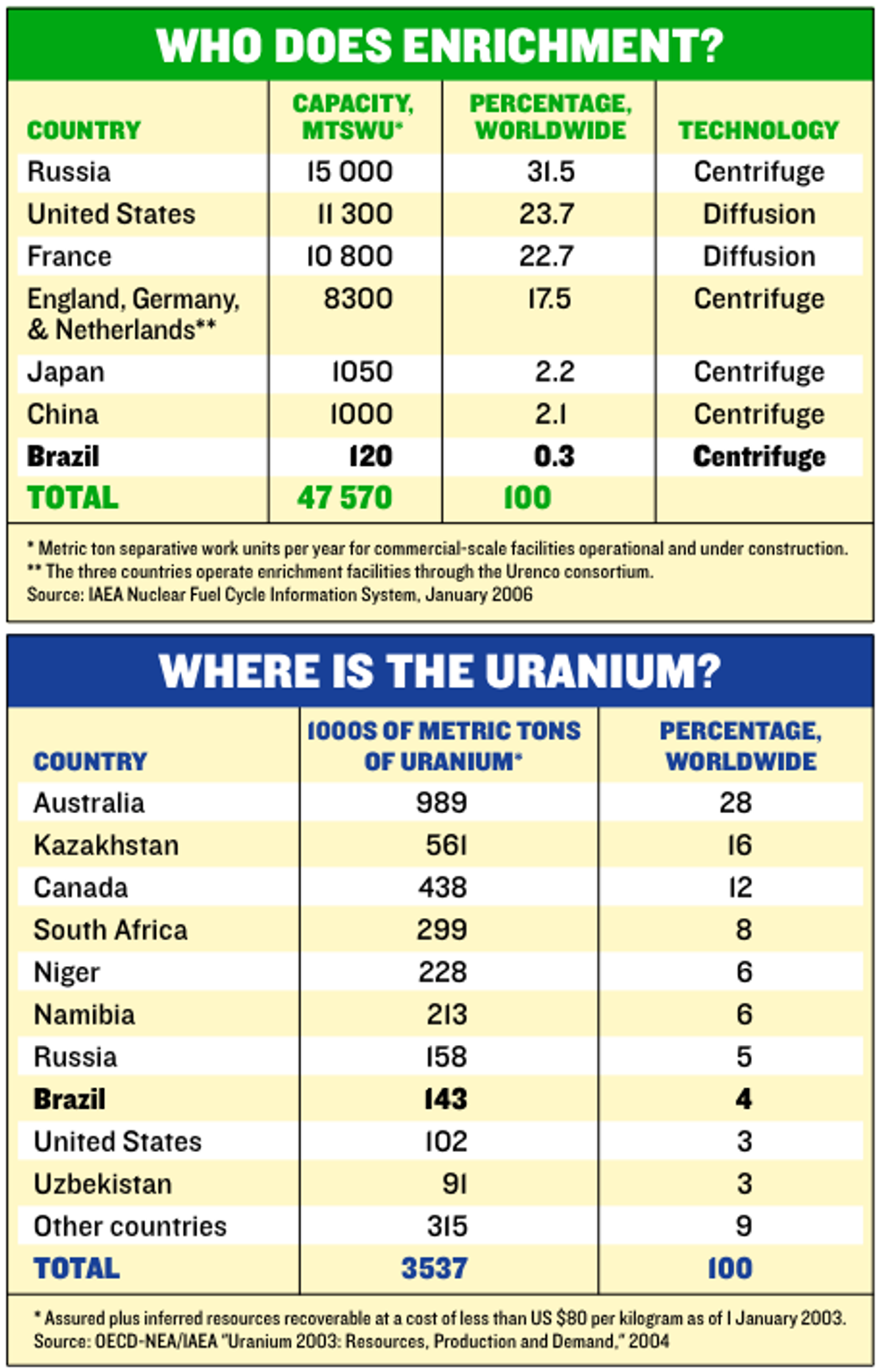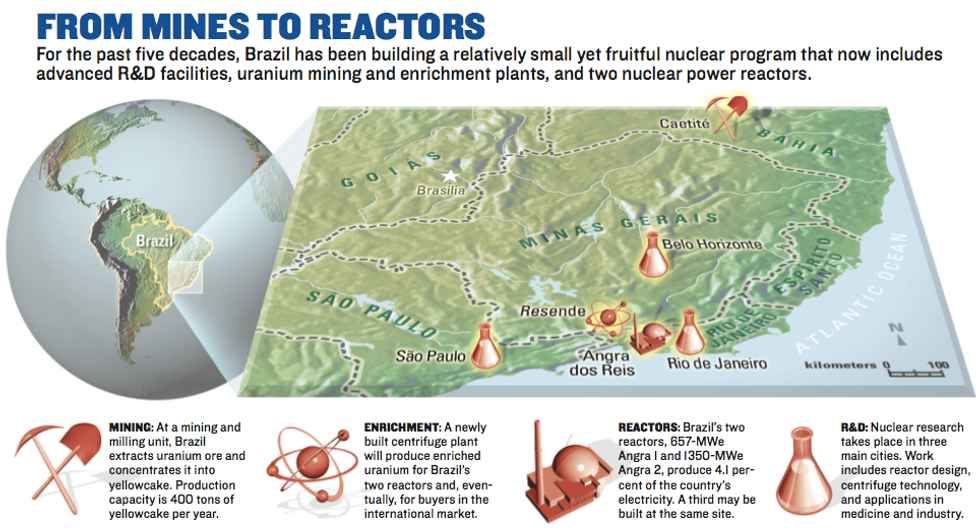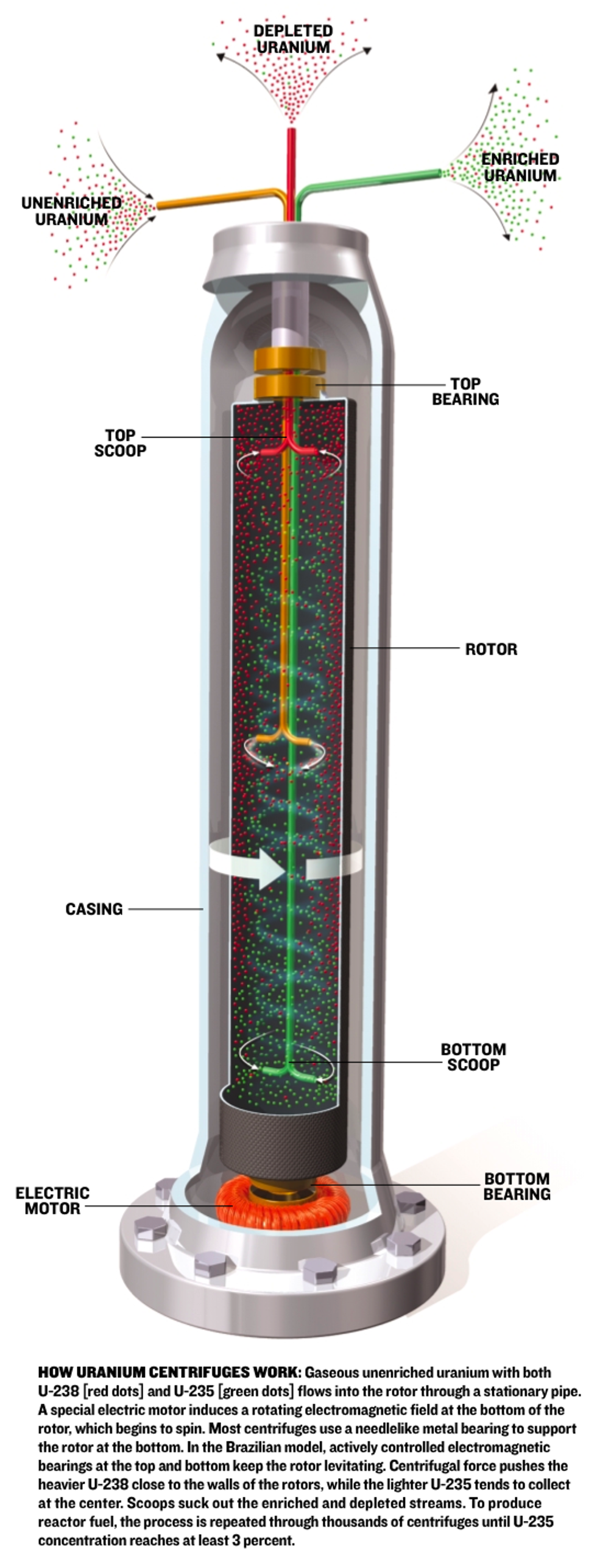How Brazil Spun the Atom
While Iran grabs headlines, Brazil is quietly, and without belligerence, preparing its centrifuges to start enriching uranium

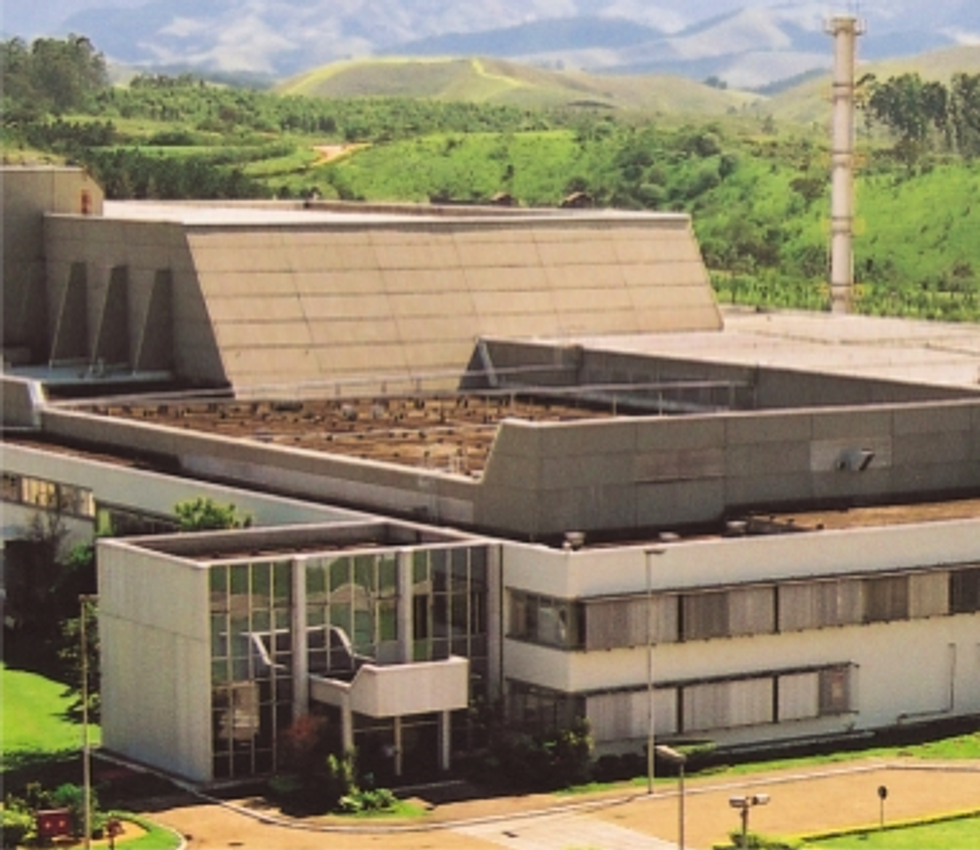
My footsteps echo across the empty corridor, and fluorescent lights flicker above my head. I’m in a compound of boxy concrete buildings at the Resende nuclear complex in southeastern Brazil. Ahead of me, behind locked doors, is a vast, high-ceilinged hall. I can’t go in there, my escort tells me, but I shouldn’t take it personally. Even among the employees here, very few have access to that hall, and those who do can’t talk about what’s in there. Inside is the newest example of one of the most heavily guarded technologies of the industrial age.
This is where Brazil will soon produce enriched uranium in industrial quantities to fuel its two nuclear power reactors. That hall—this much is known—houses hundreds of identical machines. They are slender, upright cylinders topped by a maze of thin pipes, and they sprawl around the room like a thick forest of metal. The machines are uranium centrifuges. They spin at supersonic speeds to accomplish a neat trick: separating two types of uranium atom that are virtually identical except for a minuscule difference in weight. This separation process, known as enrichment, isolates the uranium atoms that are fissile—the useful material capable of sustaining a nuclear chain reaction—from the rest.
All over the world, uranium centrifuges and other enrichment technologies are treated as state secrets and subject to stringent export controls. That’s because the same equipment used to enrich uranium into reactor fuel can, with only minor modifications, also enrich it to a far higher level to serve as bomb-grade material. So while enrichment technology provides the lifeblood of the nuclear power industry, it can also be instrumental to the production of nuclear weapons.
Brazil’s achievement comes at a time when concern is running high over another enrichment program, in Iran. Both countries are parties to the Nuclear Non-Proliferation Treaty (NPT)—the foundation of the international regime that seeks to limit the spread of nuclear weapons—but Brazil’s program is notable for its differences from Iran’s: Brazil has consistently fulfilled its obligations under the NPT, and the country has forsworn nuclear weapons ambition since a democratic government replaced the military dictatorship that ruled the country from 1964 to 1985.
With its new Resende plant, Brazil is joining the exclusive club of nations that operate commercial-scale centrifuge facilities. These include Germany, the Netherlands, and the United Kingdom— these three forming the Urenco Ltd. consortium—plus Russia, China, and Japan. The United States and France enrich uranium through a different process called gaseous diffusion, although both countries plan to build centrifuge plants.
Click to enlarge.
Brazilian officials I interviewed say that enrichment capability is important for two main reasons. The first is strategic. Brazil has the world’s eighth largest uranium reserves, and enrichment would give Brazil nuclear fuel autonomy. The second reason is economic. About 90 percent of the world’s nuclear power plants—397 of a total of 441—depend on enrichment services to get their fuel. It’s a US $5-billion-a-year global market, in which Brazil hopes to participate sometime in the future.
“Brazil has large uranium reserves, and it now has enrichment technology. We can’t ignore this opportunity,” says Samuel Fayad Filho, director of nuclear fuel production at Nuclear Industries of Brazil (INB), the state-owned company that has the monopoly to mine uranium and produce nuclear fuel. In an interview this past June in his office in Resende, a 2-hour drive from Rio de Janeiro, Fayad said that the goal is to produce 20 to 30 metric tons of enriched uranium per year, or about 60 percent of domestic fuel requirements, by 2008 or 2009, possibly reaching 100 percent by 2010.
But quite a few analysts find it difficult to understand why Brazil is putting so much effort into enrichment capability. At the moment, they say, there’s plenty more supply than demand for enrichment services, and for the scale of the Brazilian nuclear energy program it would be cheaper to buy enrichment services abroad.
Brazil currently operates two nuclear power plants. These reactors, named Angra 1 (657 megawatts of electrical output) and Angra 2 (1350 MWe), provide 4.1 percent of the country’s electricity. Today Brazil ships its uranium to be enriched in Europe. By doing this processing at home, Brazil expects to save at least $12 million per year. It’s not much compared with the 400 million reais (about $180 million) INB is putting into the plant, not to mention its operational costs.
Click to enlarge.
Whether Brazil’s bet on uranium enrichment will ever pay off depends on the world supply of nuclear fuel and also on the extent to which nuclear power generation grows in industrializing countries like China and in developed countries like the United States. As world energy needs continue to rise rapidly, and with concerns over oil prices and greenhouse gas emissions, there’s been talk of a nuclear power renaissance, and some analysts foresee a substantial increase in the demand for enrichment services.
The Brazilian government has recently completed a major review of its nuclear program. According to that study, a possible scenario is that Brazil will finish the 1300-MWe Angra 3 reactor and will build one new 1300-MWe plant and two Brazilian-designed 300 MWe plants, at a total cost of $6.1 billion. With that many plants, Brazil says it would make sense for the country to make its own fuel.
Brazil’s centrifuge plant is the newest addition to the Resende nuclear complex, which since the late 1980s has been operated by the INB as a reactor fuel fabrication facility. The 6-square-kilometer site resides in the vicinity of the lush green jungle of the Itatiaia National Park, a pocket of native Brazilian forest where you can find toucans, marmoset monkeys, and possibly even the endangered guará wolf. At the entrance to the complex, with its well-manicured lawns, you may well think you’re approaching a country club. While I was visiting the enrichment plant last year, its first linked group of centrifuges—called a cascade—was undergoing a final round of tests. Outside, a troop of construction workers was putting up new buildings to house thousands of centrifuges in nine more cascades.
The centrifuges that are being installed at Resende were developed by the Brazilian navy, which manufactures and installs them for the INB. After nearly three decades perfecting the machines, Brazilian navy engineers say they significantly improved on previous designs. Their centrifuges, which they say use 100 percent Brazilian technology, include a novel feature: their rotors—the spinning cylinders that are the heart of this type of machine—levitate, spinning frictionlessly, thanks to actively controlled electromagnetic bearings. All other centrifuges operating commercially have rotors that spin on metal pin bearings. The electromagnetic mechanism, the Brazilians say, makes their machines more efficient and durable.
The Brazilian centrifuges have yet to demonstrate those advantages, but they have already sparked a major controversy. Brazil, as a party to the NPT, has agreed to have its nuclear facilities inspected by the International Atomic Energy Agency, the United Nation’s watchdog organization, based in Vienna, Austria. But in 2004, when Brazil and the IAEA began discussing inspections at Resende, they reached a deadlock. Brazil argued that it needed to protect proprietary aspects of its centrifuges; these details apparently included size, shape, materials, and also parts of the control system that are visible. Brazil’s proposed solution was to shroud the machines with 2-meter-tall panels. The IAEA had accepted the shielding in the past, for a navy centrifuge pilot plant, but this time the agency insisted it needed full visual access to the Resende installation.
Negotiations dragged on for months, and the impasse prompted an outcry from arms control experts. Some argued that Brazil was undermining the nonproliferation regime by setting a precedent for Iran to demand the same treatment. Others claimed that Brazilian centrifuges were copies of the European design. And yet others speculated about the Resende plant’s potential to produce highly enriched uranium—enough for up to six bombs a year, according to one estimate.
Brazilian officials deny these charges. They say that Brazil can’t be compared to Iran, known to have violated the NPT, and that there was no illegal transfer of technology. As for Resende’s potential to make weapons-grade material, that claim “is baseless speculation,” says Odair Gonçalves, president of Brazil’s National Commission on Nuclear Energy.
Finally, in October 2004, Brazil and the IAEA agreed on inspection terms. Brazil reduced the size of the masking panels and accepted other procedures to guarantee that no diversion of uranium could take place in the centrifuge hall. Afterward, the IAEA seemed satisfied, and last year, the agency gave its official approval to the plant’s first cascade, which is now going into operation.
The episode, however, still puzzles some experts. “The Brazilian case, the only thing that’s really strange about it is the secrecy thing—there’s no good explanation for it,” says physicist Thomas L. Neff, a senior researcher with the Center for International Studies at the Massachusetts Institute of Technology, in Cambridge. “The Brazilians say they have proprietary technology. Well, others have proprietary technology, and they don’t seem to think that is a problem. No one else conceals their centrifuges from the IAEA.”
Experts like Neff insist that Brazil needs to be more transparent, or suspicions will remain. The problem, they say, is that uranium centrifuges have been tainted by a number of proliferation incidents. In the 1980s, Iraq experimented with centrifuges it acquired from German technicians who had stolen Urenco’s designs. Iran, Libya, and North Korea are all believed to have acquired centrifuge technology from a secret smuggling network—exposed in 2004—set up by Abdul Qadeer Khan, the former head of Pakistan’s nuclear weapons program, who also obtained classified designs from Urenco.
The sensitivity of enrichment technology became evident during a conference of the treaty signatories this past May to review the NPT. “Without question, improving control over facilities capable of producing weapon-usable material will go a long way toward establishing a better margin of security,” said Mohamed ElBaradei, director general of the IAEA, at the opening of the conference in New York City. No such improvements came out of that conference, however. Today, as the standoff with Iran suggests, experts aren’t really sure what is the best way—or whether it’s even possible—to tighten control over sensitive nuclear technologies, and some are even suggesting that the nonproliferation regime is dangerously eroding.
Click to enlarge.
The nuclear fuel cycle is a sprawling, technology-intensive, and expensive series of industrial processes that produce enriched uranium for the global market. It begins with mining uranium ore, which is extracted from the earth and concentrated into a powder of uranium oxides called yellowcake. In this natural form, it contains mainly two types of uranium atom: U-235 and U-238. The isotope U-235 is fissile, and therefore its nuclear energy can be harnessed in a reactor, while U-238 is not. But as it happens, natural uranium is 99.3 percent U-238 and only 0.7 percent U-235. That’s why enrichment is necessary.
Most nuclear power plants use low-enriched uranium, typically 3 to 5 percent U-235, as fuel. Nuclear bombs are normally fashioned with highly enriched uranium containing at least 90 percent U-235. (A few reactor types, such as the Canadian Candu and the British Magnox, can operate with natural uranium, but they require heavy water or graphite to facilitate the nuclear chain reaction.)
To enrich uranium, you need first to convert the yellowcake into a gas, toxic and highly corrosive, called uranium hexafluoride. Next comes the enrichment itself, or the separation of the useful U-235. Of all known enrichment methods, which number fewer than 10, only two are used on a commercial scale: gaseous diffusion and centrifuges. In the diffusion process, the separation is done by pumping the gas into chambers divided by porous metal membranes, through which the U-235 diffuses slightly more swiftly.
In the centrifuge process, the gas is injected into a cylinder rotating at speeds as high as 90 000 revolutions per minute. Centrifugal force pushes the U-238 closer to the wall of the rotor, while the ever-so-slightly lighter U-235 tends to collect closer to the center. By means of temperature variation along the rotor, the U-238 and U-235 fractions circulate and flow into scoops. Each centrifuge increases the U-235 concentration by only a tiny fraction, so thousands of machines need to be linked in cascades. Centrifuges revolutionized the economics of enrichment by requiring less expensive equipment, less energy, and less space than diffusion.
After enrichment, the next stage in the cycle is nuclear fuel fabrication. The uranium hexafluoride, now richer in U-235, is transformed into uranium dioxide, a dark powder, which is then pressed into small ceramic pellets. These are put into large metal pillars called fuel assemblies, which form the nuclear core of a reactor.
As the fuel is used in the reactor, the concentrated U-235 is depleted and must be replenished. The spent fuel can be sent to permanent storage, or it can be reprocessed. Reprocessing separates the U-235 that didn’t undergo fission, of which there’s lots, and this material goes back through the enrichment stage to become fuel again. By-products of reprocessing include plutonium; one of its isotopes in particular, Pu-239, is an alternative to highly enriched uranium for making atomic bombs. In fact, reprocessing plants, like enrichment plants, are of great concern for nonproliferation efforts.
Both the United States and Germany experimented with centrifuges to enrich uranium during World War II. American scientists, drawing on work by centrifuge pioneer Jesse W. Beams, tried to advance the method but lacked high-strength materials and wound up going with the diffusion method. The Germans also ran into material problems, and their centrifuge efforts faltered. After the war, Austrian and German scientists abducted by Russia developed some of the first successful designs. An Austrian scientist, Gernot Zippe, is widely credited as the father of the modern uranium centrifuge. His design included the key elements that made the machines efficient and reliable: a needlelike metal bearing that supports the rotor at the bottom and a set of magnets that keep the top of the rotor stable.
Theory shows that a centrifuge’s output is directly proportional to the length of the rotor and to its speed to the fourth power. “So you want to make it as long as you can and go as fast as you can,” says Houston G. Wood, a professor of mechanical and aerospace engineering at the University of Virginia, in Charlottesville. Wood, who worked on the U.S. Department of Energy centrifuge project, revived during the 1960s, adds that as you accelerate the rotor, it will pass through a certain speed at which it will start to resonate, rapidly vibrating just like a guitar string. So although faster rotors are desirable, they need to be carefully engineered to go through this critical speed, or they can fly apart. A centrifuge is called subcritical if it operates below this speed and supercritical if it goes above.
Different countries met these engineering challenges in different ways. The Russians preferred to keep the centrifuges simple—less than 1 meter tall and subcritical—and manufacture millions of them. Urenco opted for carbon fiberbased machines that are more than 3 meters tall and are supercritical. And USEC Inc., in Bethesda, Md., is developing supercritical machines that exceed 10 meters and are expected to become operational by 2010 at a centrifuge plant in Piketon, Ohio.
The electromagnetic bearings of the Brazilian centrifuge eliminate all points of contact, and therefore friction, between rotating and fixed parts in the machine. One of the many technical challenges was to design a control system able to keep the levitating rotor spinning in perfect balance. The details of how the system works, such as how many bearings are used and where they are positioned, are classified. But Roberto M. Sales, an electrical engineering professor at the University of São Paulo who consulted on the project, did say that basically the control functions by sensing the displacement of the rotor from a reference position. “You measure the gap and act on the currents flowing through the electromagnets,” he says.
Some centrifuge experts say that Urenco experimented with electromagnetic levitation but discarded it because the rotors became too heavy to be suspended. The University of Virginia’s Wood says that he knows of other experiments with levitation in uranium centrifuges, but he did not elaborate.
But the question many are asking is, how well does the Brazilian centrifuge work compared with its competitors? For one thing, it is not straightforward to compare these machines, given the secrecy surrounding details such as their manufacturing cost, energy consumption, and durability. But one parameter that serves as a technology benchmark is the “separation power” of a centrifuge. This parameter is given in separative work units, or SWU, and it is related to the energy needed to separate U-235 and U-238 for a certain enrichment level. The less technically advanced machines, such as those reportedly used by Iran, each have a capacity of 3 SWU per year. State-of-the-art machines, such as those used by Urenco, are estimated to have a capacity of 50 to 100 SWU. The new American centrifuges are designed to operate at 300 SWU, assuming they will work.
Brazil’s centrifuges have a capacity of around 10 SWU or a little more, sources familiar with the project told me. These sources, who spoke on condition of anonymity because of the classified nature of the project, say that the machines are nearly 2 meters tall and are supercritical. They add that Brazilian navy researchers are now attempting to increase the length of the rotor without having to redesign its driving and bearing systems. That modification, they say, could improve the machines’ performance.
Brazil’s patient pursuit of uranium-enrichment technology shows how a country with sufficient determination can methodically assemble all elements of a complete nuclear fuel cycle industry. Its recent success is the culmination of an effort that dates back almost to the end of World War II, when Brazil first began exploring the possibilities of nuclear energy.
In the 1950s, Brazil and the United States signed a nuclear cooperation agreement under the Atoms for Peace Program, and Brazil received two research reactors. Then, in 1971, Brazil bought its first power reactor, Angra 1, from Westinghouse Electric Corp. But wary of becoming too dependent on American technology and fuel, and also worried about Argentina’s nuclear development, Brazil looked for other deals. It was West Germany that made the best offer.
In 1975, the two countries signed a multibillion-dollar agreement that included a total of eight 1300-MWe reactors, to be built in 15 years, as well as the transfer of a complete fuel-cycle industry. At the time, Brazil wasn’t a signatory to the NPT, and the deal was strongly opposed by the United States. Due to foreign pressure, Brazil eventually agreed to put its nuclear installations under international safeguards. But the deal crumbled as a deep economic crisis engulfed Brazil in the 1980s. Construction of Angra 2, the first reactor included in the deal, fell far behind schedule and went over budget. Worse still, Brazil squandered perhaps as much as $100 million on an enrichment plant based on a method called jet-nozzle technology, which had worked in German labs but proved uneconomical on larger scales.
A few years before, with inklings of such difficulties looming, Brazil’s military government decided to start another nuclear program—one that didn’t depend on foreign technology and wouldn’t be restricted by international safeguards. The then-secret effort became known as the parallel program. Although there were military factions extremely interested in acquiring nuclear weapons capability, the parallel program wasn’t a concerted effort in that direction, former officials of the program insist. The program involved Brazil’s three armed forces. The army had plans for a graphite-moderated reactor using natural uranium, while the air force began researching an enrichment method using lasers. But it was the navy’s program that became the largest and most successful. Its goal was to use nuclear energy for submarine propulsion. That application would require a compact nuclear reactor and also enriched uranium—fuel that would be difficult to acquire abroad. Brazil needed to make its own.
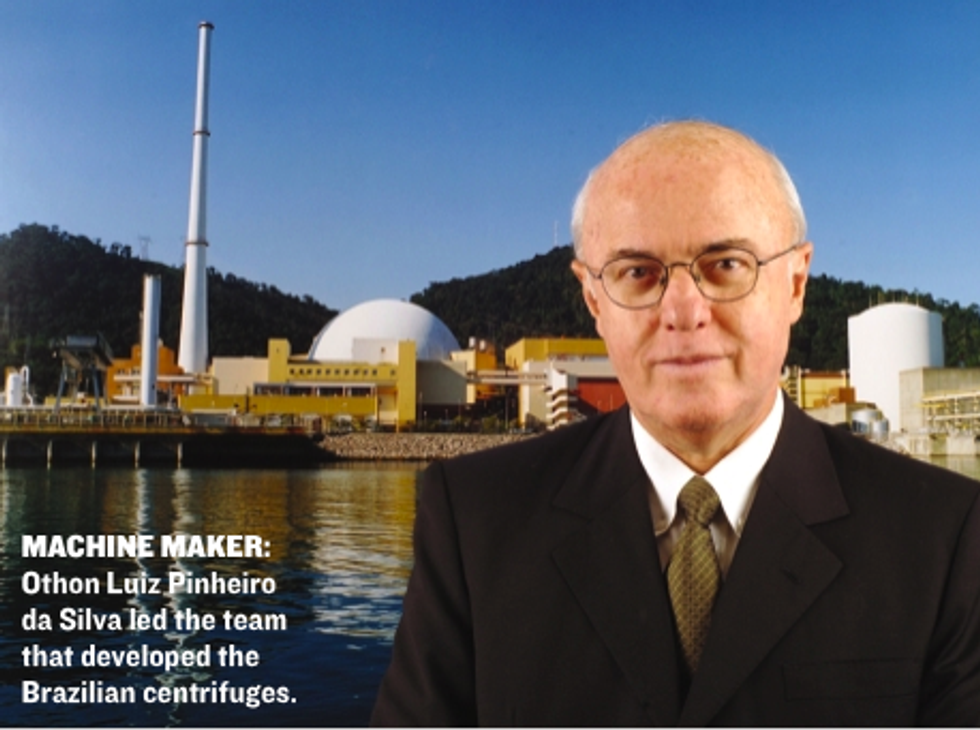
So in 1979 the navy organized a program, code-named Project Cyclone, for its centrifuge efforts. It was led by Othon Luiz Pinheiro da Silva. Just a few years before, in 1975, da Silva was a young navy officer when he was sent to MIT to get a master’s in nuclear engineering. In a phone interview from his home in Rio de Janeiro, da Silva, now president of Eletronuclear, the state-owned company in charge of operating the Angra 1 and Angra 2 reactors, recalls a course taught by MIT professor Manson Benedict on nuclear chemical engineering. Benedict, who had directed the diffusion enrichment program at Oak Ridge, Tenn., for the Manhattan Project, told the students about the inefficiencies of the jet-nozzle technology, joking offhand that Brazil had bought the technology believing it would work. Da Silva says that episode convinced him that Brazil would need to find another enrichment method.
Still at MIT, da Silva attended a talk by an Oak Ridge scientist in charge of uranium centrifuge research. The lecturer mentioned his group was experimenting with a machine that didn’t have a mechanical bearing like most others but used a more advanced system obtained from NASA. Da Silva learned later that the mysterious system involved actively controlled electromagnetic levitation, a topic that, in fact, NASA was studying at the time. “For me, the pieces of the puzzle were all there,” he says.
When da Silva was charged with the navy’s submarine project after his return to Brazil, he began by recruiting seven engineers and setting up shop at the Institute for Energy and Nuclear Research, or IPEN, on the campus of the University of São Paulo. “We had only a small group and almost no money,” he recalls. “But it was a very animated and informal workplace. We worked as a family.”
On 8 September 1982, da Silva and his group, using a single centrifuge, performed their first successful enrichment experiment. They made the rotor using maraging steel, a steel alloy that has both high tensile strength and high malleability. It was a simple design, which already included the electromagnetic bearings. “From the beginning we decided that was going to be our machine’s key technical difference,” says Claudio Rodrigues, a physicist who was part of the initial Cyclone group and is now superintendent of IPEN.
In 1987 the Brazilian researchers put together a small module with 48 centrifuges, and in 1991 they expanded it to about 500. During those years, the group also developed or acquired all the tools and materials required for industrial production of centrifuges and their piping systems. Some manufacturing equipment came from a group of Germans who had helped Iraq’s clandestine centrifuge efforts. Did they help Brazil too? The Brazilians say the sale was legal and involved no classified data. On other occasions, to facilitate the acquisition of certain items, the Brazilians didn’t tell suppliers that their products were being used in an enrichment program, or the companies would have refused to sell them. Perhaps suspicious of such activities, the United States kept the navy’s program under close watch and even dispatched American agents based in São Paulo to follow da Silva around, according to a secret report by the Brazilian navy.
When da Silva left the program in 1994, he says, the group was testing a third-generation machine made of carbon fiber. These are the centrifuges, he adds, that the navy is now fabricating for the Resende plant. Project Cyclone, through late 2004, spent about $250 million in equipment and infrastructure. Work on the centrifuges continues at the Navy Technology Center in São Paulo (CTMSP), next door to IPEN, while manufacturing takes place at the navy’s Aramar Experimental Center, in Iperó, outside São Paulo. (Last year, I asked the Brazilian navy for interviews at CTMSP, but the request was denied.)
In the late 1980s, shortly after a democratic government replaced Brazil’s military regime, the parallel program’s secrecy, spending, and goals came under attack. Press reports and an investigation by the Brazilian congress revealed the existence of secret bank accounts used to fund the program. It also found that the air force had drawn up plans to build a nuclear bomb and test it at a site in north Brazil. The military never commented on these reports.
In 1988, Brazil approved a new constitution, which stated that nuclear energy would be used only for peaceful purposes, and in 1991, Brazil and Argentina, pledging not to make atomic bombs, established a mutual inspection agency. During the following years, the government began dissolving many of the parallel program’s initiatives and integrating others into the Ministry of Science and Technology. In 1997, Brazil finally signed the NPT and opened all its nuclear facilities, including the Aramar navy complex, to the IAEA.
These developments helped convince many people inside and outside Brazil that the country has abandoned any nuclear weapons ambitions. “I’m not worried about Brazil trying to get nuclear weapons,” U.S. Secretary of State Condoleezza Rice said last April in a radio interview before a visit to Brazil. “Brazil wants a civil nuclear program, and I think that we should help countries develop nuclear energy for civilian purposes, but so that they don’t create nuclear weapons.”
Some international observers, however, aren’t thrilled by Brazil’s enrichment plans. They say that Brazil’s achievement reinforces the notion that the nonproliferation regime is flawed, because it shows that countries can acquire potentially useful military capability without ever flouting the requirements of the NPT. Some critics even go so far as to suggest that the world should not accept the Resende plant and that Brazil should be pressed to abandon it.
To that argument, Brazilian officials respond that the NPT guarantees that signatories have the right to explore nuclear energy for peaceful purposes, including developing a nuclear fuel cycle industry in their own territories. That provision, known as Article IV, is in fact one of the core bargains of the NPT.
The 2005 NPT review conference showed that Article IV had become a critical issue: the conference foundered as some countries demanded more control of sensitive nuclear technologies, while others complained about the lack of progress toward disarmament.
“The recognition that countries could exploit Article IV to obtain nuclear weapons has led everybody from Mohamed ElBaradei to President Bush to argue that there have to be some modifications in the way we do nuclear business,” says William C. Potter, director of the Center for Nonproliferation Studies at the Monterey Institute of International Studies, in California.
In 2004, the Bush administration urged a halt to the spread of enrichment and reprocessing technology, insisting that countries that don’t already produce nuclear fuel should be prevented from developing that capability. Meanwhile, IAEA’s ElBaradei has called for a five-year moratorium on new enrichment and reprocessing facilities. During this period, the IAEA says it will try to establish a plan to enable the agency to act as “a guarantor for the supply of fissile material to civilian nuclear users” through suppliers it authorizes and at market rates.
But Brazil says that such proposals would put restraints on its ability to develop its nuclear industry. “We don’t think this is the way,” says Santiago Mourão, head of the disarmament and sensitive technologies division of the Ministry of Foreign Affairs in the capital, Brasília. “The international community is legitimately concerned with proliferation and we understand that, but we think that the way to avoid proliferation doesn’t involve denying access to technology.”
Moreover, nuclear technology is part of a broader industrial policy that is necessary for the country’s growth, says Brazilian geophysicist Paulo Barretto, a former director of technical cooperation programs at the IAEA. It is used, he says, in medical devices and treatments, in industrial equipment and processes, in agricultural research, and other applications. “Brazil should not abandon the Resende plant,” he says. “What we have to do is to convince the world that Brazil is serious, that we follow the treaties, and that we have nothing to hide. Brazil should in no way go back on this.”
To Probe Further
An IAEA report on Brazil’s nuclear industry is available at https://www-pub.iaea.org/MTCD/publications/PDF/cnpp2003/CNPP_Webpage/countryprofiles/Brazil/Brazil2003.htm.
For more on Brazil and related nonproliferation issues see “Brazil as Litmus Test: Resende and Restrictions on Uranium Enrichment,” by S. Squassoni and D. Fite, Arms Control Today, October 2005, and “Making the World Safe for Nuclear Energy,” by J. Deutch et al., Survival, Winter 200405.
For more on Brazil’s nuclear submarine project, see article by L.S. Guimarães in Economy & Energy, no. 53, December 2005/January 2006, available at https://www.ecen.com.
“The Military Nuclear Program in Brazil,” by Michael Barletta, brings a detailed account of Brazil’s nuclear history: https://iis-db.stanford.edu/pubs/10340/barletta.pdf.
